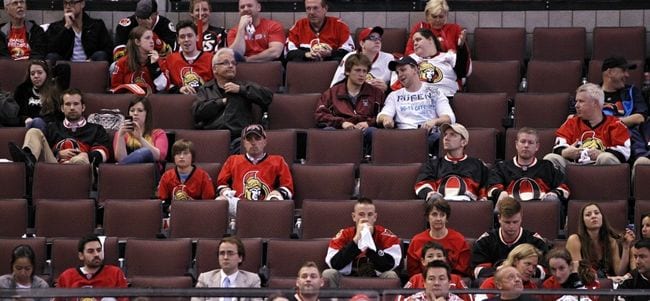Faced with tepid fan interest in spite of a run to the NHL East Conference finals this spring, the Ottawa Senators management has come up with an innovative solution: Cut their arena down to size.
No, they didn’t move to a new barn. No, they didn’t put together extensive renovations over the summer. Instead, they just put a black tarp over approximately 1,500 of the cheap seats at the top of the stadium.
“Our building is too big for the market,” said Senators president Tom Anselmi in a piece on TSN.ca. “Our upper bowl is way bigger than people are building nowadays. That’s what drove the thinking. How do we create scarcity? How do we make it a little smaller and how do we make it a little easier to fill the place?”
Specifically, the top six rows in the upper reaches of the stadium are covered with the draping, and are “permanently out of the manifest,” Anselmi says. “They are the cheapest seats in the building, and they were the ones that weren’t selling.”
It’s an interesting way of looking at things. Granted, Ottawa has a population of under one million (just over if you count the metropolitan area). That’s substantially smaller than nearby Montreal, which also boasts an Original Six NHL squad in Les Habitants (the Canadiens for those not versed in hockey lore). It’s also far smaller than Toronto, home of another revered, if snake bitten, franchise in the Maple Leafs.
The Senators were actually an original NHL franchise and captured 11 Stanley Cups – but moved to St. Louis in the 1930s. The franchise was revived in 1992 and has had up and down success since that time. From 1998-99 to 2005-06, the team finished first in the Northeast division four times in seven seasons (not counting the cancelled 2004-05 season). In 2007, the team advanced to the Stanley Cup finals, falling in five games to the Anaheim Ducks. Since that point, however, the team missed the playoffs four times and only advanced out of the first round once before last season’s run to the conference final, where it fell to eventual Stanley Cup champions the Pittsburgh Penguins in seven games.
Anselmi pointed out the fact that the Nashville Predators, who were lauded for their rabid home fans (and drew the ire of many by cancelling tickets purchased outside of a radius of their stadium) had a “sellout” level at their home arena that was over 1,000 seats fewer than the Senators average of over 18,000 during the playoffs.
A piece in the Ottawa Citizen points out that the Senators’ move is not unprecedented in the NHL, even recently. In 2010, the Florida Panthers closed off nearly 2,500 seats. The Arizona Coyotes are doing the same for many games this year, reducing their capacity to under 16,000 by tarping off upper-level seats.
“You can stimulate demand by creating scarcity,” says Michael Mauws, the executive director of the Calgary-based Business of Hockey Institute who also teaches at Athabasca University’s MBA in hockey business. Maybe the Senators have learned something from the Winnipeg Jets, whose home arena, Bell MTS Place, has seating for just over 15,000 fans, the smallest capacity of any NHL arena.
“It seems to have paid off in terms of the environment. It’s always sold out, it’s always noisy,” says Mauws. “People will pay to be part of that environment rather than sit in a half-empty barn. You want to be at an event that others want to be at. When you hear that something is sold out, it exacerbates demand.”
If economics say the decision makes sense, that’s one thing. But the optics of a team that fell a few bounces of the puck shy of playing for the NHL’s most precious trophy (and the dream of every Canadian I’ve ever met) certainly aren’t ideal. Time will tell if the Senators become a hotter ticket – and whether or not that tarp will come off if they start bumping against that arena capacity more often than not.




